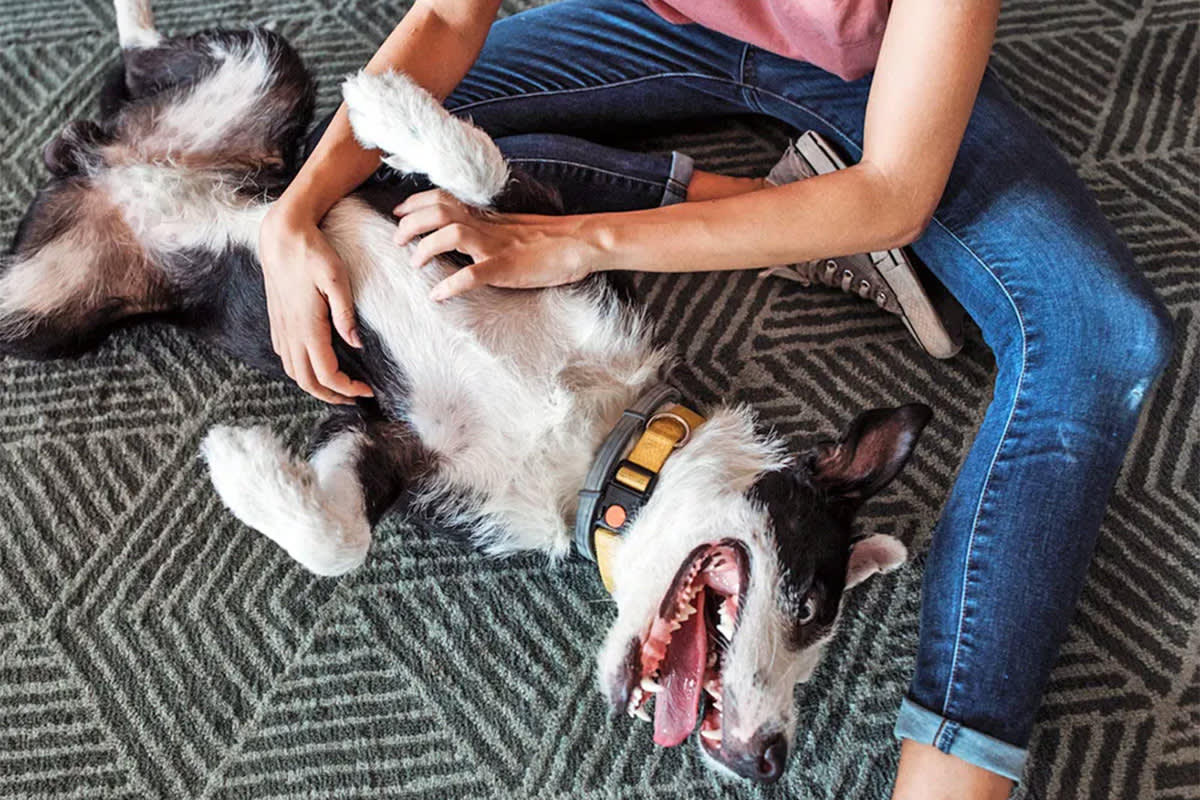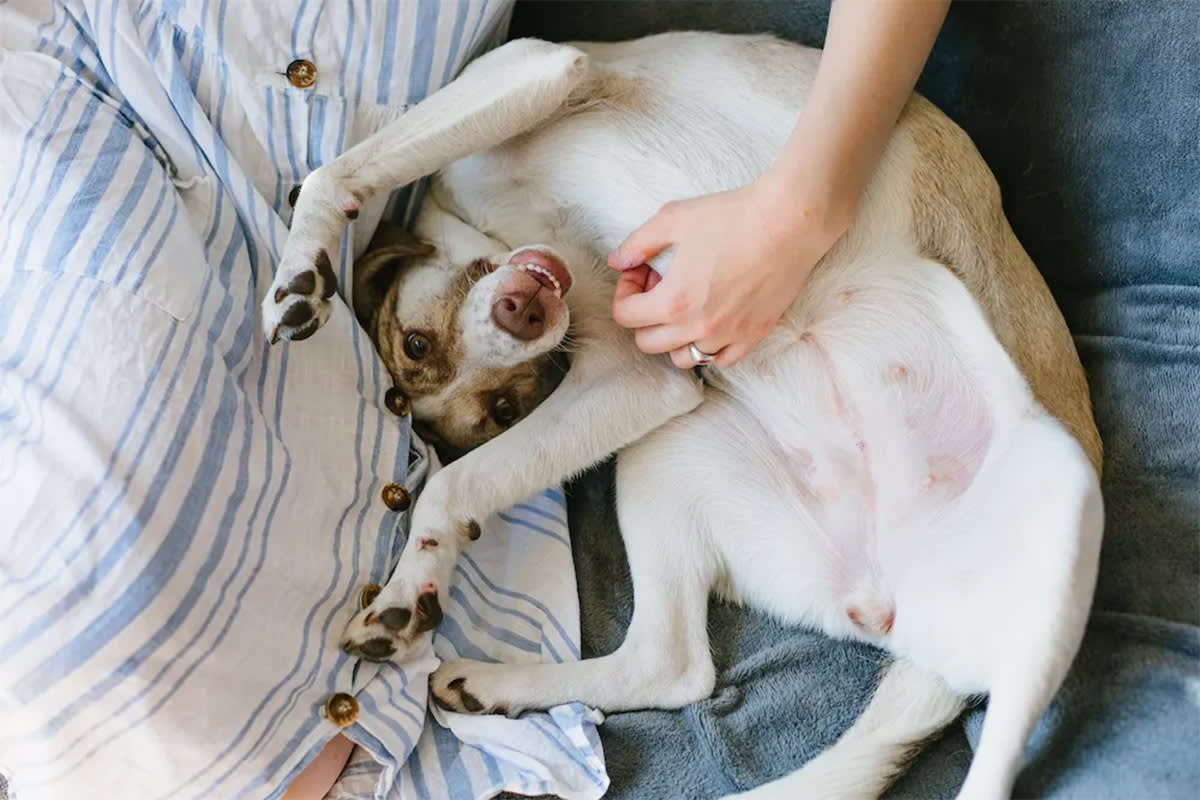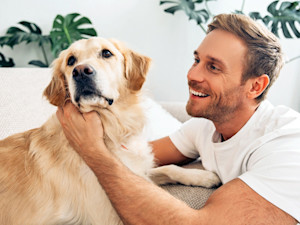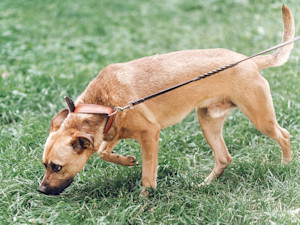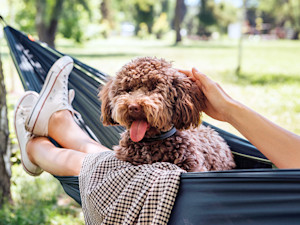Why Do Dogs Show Their Bellies?
It’s not just for belly rubs and attention. Know their body language to stay safe.
You’re arriving at your friend’s home, and their dog is greeting you at the door. They’re happy you’re here! Their tail is wagging, their tongue is out, and they flop onto the floor, showing their tummy.
Are they simply begging for belly rubs, or should you have caution before going for it?
Trick question: All dogs are perfect! But find out which type is the best fit for you.
Typically, dogs flipping onto their backs to show their stomachs means they’re begging for belly rubsopens in new tab, but the true reason why they’re showing their belly is a mystery. “We’d really have to talk to dogs directly, but I’m sure there are some dogs that get some pressure off their back by laying on it” or are scratching their backsopens in new tab, says Brian Lee, dog behaviorist at his business Way of the Dog.comopens in new tab.
If they’re truly scared, dogs won’t show their bellies. They need some confidence to be submissive, Lee says. “That’s why you see your dog laying on his back while sleepingopens in new tab. Obviously, if it didn’t feel it was a safe environment, it wouldn’t sleep that way.”
How much do you spend on your pet per year?
Similarly to when a person can’t be vulnerable or intimate due to trauma, their guard is up. When dog is in fight or flight, it won’t roll on its back. “That’s why a dog rolling on its back, in general, 90% of the time it’s a good sign,” Lee says.
But what about when it’s not a good sign?
Why Would a Dog Show Its Belly if Scared?
Dogs aren’t always showing their bellies in a grab for attention or affection. A common reason is submissive behavior, also called a submissive rollover, says Sara Scott, CPDT-KA and SAPro at their dog behavior and training business in the San Francisco Bayopens in new tab.
“It’s sort of like the dog is saying, ‘I mean no harm to you, don’t hurt me’ as they roll over, which is the opposite of the dog saying, ‘please touch my body and pet me,’” Scott says.
A submissive rollover is something that animals do in the wild. In groups like wolf packs, exposing the belly is a way to appease and avoid conflict with more dominant pack members, showing that they aren’t a threat. “That said, our domesticated pet dogs are certainly not wolves,” Scott says.
Lee notes that in nature, the alpha walks in and the rest of their pack backs up, lowers their heads, and might show their belly, then quickly flipping back over.
Evolutionarily, “these are predatory killing machines that live with us,” Lee says. With 20-25% of the human population having been bit by a dogopens in new tab, people should use caution and not force themselves on another creature, risking dangerous situations, he adds.
What Is Some Body Language for Fear-Based Belly Exposure?
“Body language doesn’t lie,” Lee says, adding that their body movements are all that animals can really use to communicate. Half the body can’t be comfortable enough to be excited for belly rubs while the other half is tense. “All the cues add up,” and it depends on the context, he says.
If they’re doing a submissive or fearful rollover, the dog will be tense, with a stiff body and will either avoid eye contact or be showing “whale eye,” as Scott calls it, where the head is slightly turned, and eyes are wide with the whites showing.
Here are signs that rolling over isn’t for belly rubs, and people should take caution:
Closed mouth
Yawning
Licking their lips
Tail is tucked
Crouching lower
Trembling
Freezing in place
Head turned away, with only the whites of eyes showing
Moving away when reached out to
The belly exposure alone isn’t enough to tell that the dog wants belly rubs. If a dog is showing any combination of these body signals, “the dog is not feeling secure and you should give them space,” Scott says.
What If It Really Is About Belly Rubs?
If a dog really is wanting belly rubs, their body languageopens in new tab is going to be much different. “A dog that’s truly soliciting belly rubs will have a relaxed, wiggly body, tail waggingopens in new tab, open mouth (maybe with tongue out), and will be making eye contact with you. They might even paw at you or nudge you, and they’ll approach you and then flop over,” Scott says.
This is the go-ahead that rubbing the dog’s belly is safe, because they clearly feel comfortable unthreatened.
Some dogs learn to ask for belly rubs — and they will do it repeatedly. “In other words, they rolled over and a human touched their belly enough times that they started realizing that rolling over would produce the consequence of a belly rub,” Scott says. When they enjoy the belly rubs, they will roll over more and more frequently.
Lee has also worked with pet owners whose dogs roll over to beg for belly rubs constantly. “Owners can’t help themselves but bend over and pet the dog,” Lee says, adding that doing this repeatedly is “total manipulation.”
If a dog is requesting belly rubs too frequently, Lee recommends to his clients that they only pet the dog when it’s laying on its stomach, to eventually train the dogopens in new tab out of the behavior.
“Dogs are very good at working the owners,” Lee says. But it’s important to work with the dog to establish trust and good behavior.


